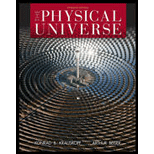
Concept explainers
Water at 50°C can be obtained by mixing together which one or more of the following? Which of the others would have final temperatures higher than 50°C and which lower than 50°C?
- a. 1 kg of ice at 0°C and 1 kg of steam at 100°C
- b. 1 kg of ice at 0°C and 1 kg of water at 100°C
- c. 1 kg of water at 0°C and 1 kg of steam at 100°C
- d. 1 kg of water at 0°C and 1 kg of water at 100°C
(a)
Whether mixing of given samples will result water having temperature equal to
Answer to Problem 87E
The mixing
Explanation of Solution
Given info: The samples are
Write the expression for the heat energy absorbed when ice at
Here,
Substitute
Write the expression for the heat energy liberated when the steam becomes water at the boiling point of water.
Here,
Substitute
Thus the
Write the expression for the heat energy gained while increasing the temperature of a substance.
Here,
In the mixing process, the total heat gained by the ice will be equal to the total heat lost by the steam.
Solve for
Substitute
Conclusion:
Therefore, the mixing
(b)
Whether mixing of given samples will result water having temperature equal to
Answer to Problem 87E
The mixing
Explanation of Solution
Given info: The samples are
In the mixing process, the heat gained by the ice will be equal to the heat lost by the water.
Solve for
Substitute
Conclusion:
Therefore, the mixing
(c)
Whether mixing of given samples will result water having temperature equal to
Answer to Problem 87E
The mixing
Explanation of Solution
Given info: The samples are
In the mixing process, the heat gained by the water will be equal to the heat lost by the steam.
Solve for
Substitute
Conclusion:
Therefore, the mixing
(d)s
Whether mixing of given samples will result water having temperature equal to
Answer to Problem 87E
Mixing of
Explanation of Solution
Given info: The samples are
In the mixing process, the heat gained by the water will be equal to the heat lost by the steam.
Solve for
Substitute
Conclusion:
Therefore, mixing of
Want to see more full solutions like this?
Chapter 5 Solutions
The Physical Universe
- 8. With the aid of a diagram draw the following electric circuit and use the resistor as the load, (a) Closed circuit (b) Open circuitarrow_forwardLab 8 Part 3 PHET Wave Interface simulation. I am having trouble with this part of the lab.arrow_forwardMick and Rick are twins born on Earth in the year 2175. Rick grows up to be an Earth-bound robotics technician while Mick becomes an intergalactic astronaut. Mick leaves the Earth on his first space mission in the year 2200 and travels, according to his clock, for 10 years at a speed of 0.75c. Unfortunately, at this point in his journey, the structure of his ship undergoes mechanical breakdown and the ship explodes. How old is Rick when his brother dies?arrow_forward
 College PhysicsPhysicsISBN:9781305952300Author:Raymond A. Serway, Chris VuillePublisher:Cengage Learning
College PhysicsPhysicsISBN:9781305952300Author:Raymond A. Serway, Chris VuillePublisher:Cengage Learning College PhysicsPhysicsISBN:9781285737027Author:Raymond A. Serway, Chris VuillePublisher:Cengage Learning
College PhysicsPhysicsISBN:9781285737027Author:Raymond A. Serway, Chris VuillePublisher:Cengage Learning
 Physics for Scientists and Engineers, Technology ...PhysicsISBN:9781305116399Author:Raymond A. Serway, John W. JewettPublisher:Cengage Learning
Physics for Scientists and Engineers, Technology ...PhysicsISBN:9781305116399Author:Raymond A. Serway, John W. JewettPublisher:Cengage Learning Principles of Physics: A Calculus-Based TextPhysicsISBN:9781133104261Author:Raymond A. Serway, John W. JewettPublisher:Cengage Learning
Principles of Physics: A Calculus-Based TextPhysicsISBN:9781133104261Author:Raymond A. Serway, John W. JewettPublisher:Cengage Learning Physics for Scientists and EngineersPhysicsISBN:9781337553278Author:Raymond A. Serway, John W. JewettPublisher:Cengage Learning
Physics for Scientists and EngineersPhysicsISBN:9781337553278Author:Raymond A. Serway, John W. JewettPublisher:Cengage Learning





